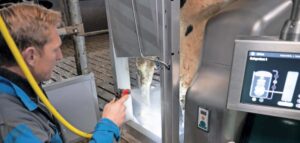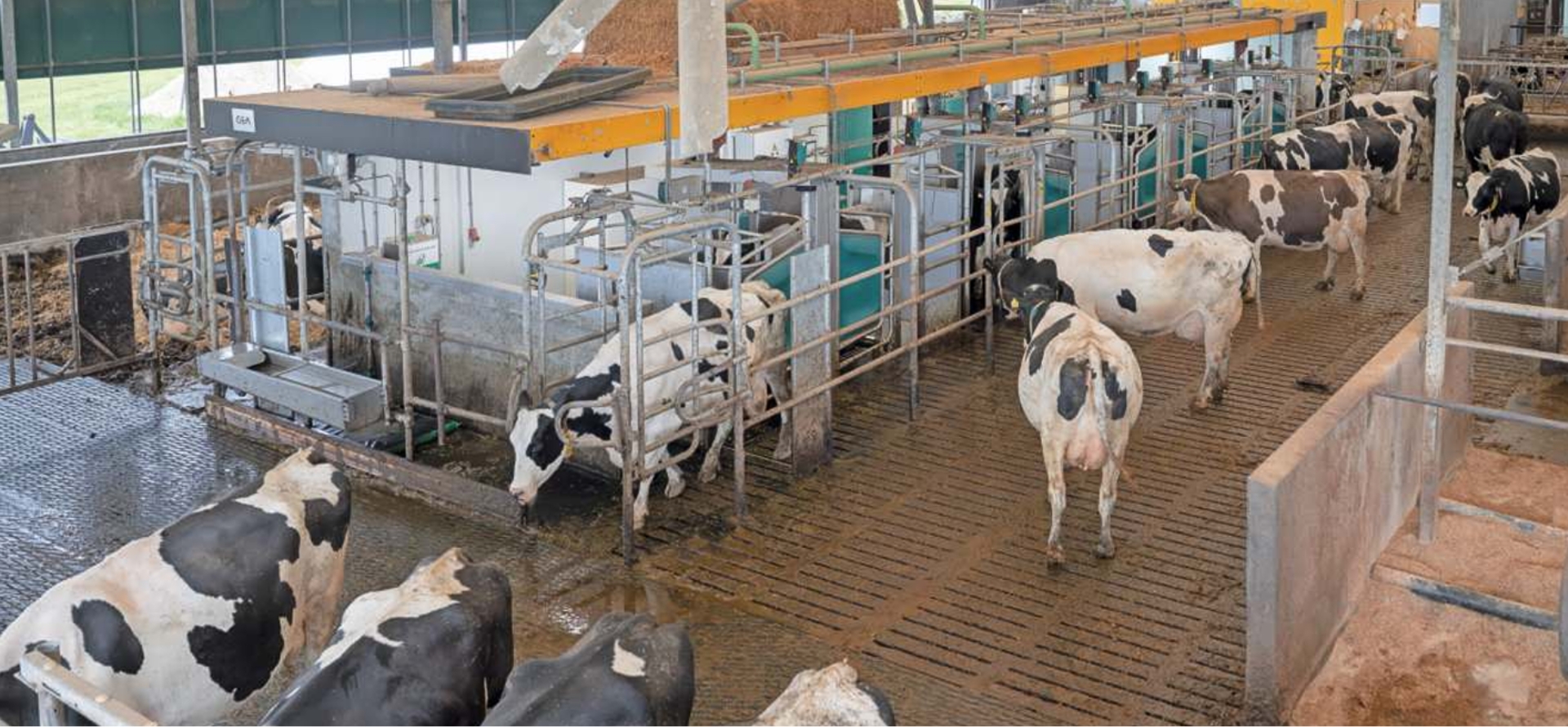“Many more milkings with new milking robots”

Click here for the article in the Boerderij
At dairy farm Bakker, the old 4-box MIone has been replaced by four separate, in-line milking robots. This has greatly improved capacity.
Johan Bakker walks behind his milking robots when two cows report for milking. One is refused, the other is quickly connected by one of the four robots. The four GEA R9500 robots have been there for a year now. This is not the first time that the company has milked with an automatic milking system. The greenhouse stable was built in 2008. This 0+6+2 row stable offers space for 200 milking animals. These walk behind the four robots and occupy the three double-row boxes. The other double-row box is used by the young cattle.
When the barn was built, Bakker also switched to automatic milking. At the time with a Titan 4 box system. That milked very poorly. The brand was taken off the market and replaced by GEA with a 4 box MIone. “The promise was that this machine would have a capacity of 200 cows. Exactly what we had set up the barn for and what was also our goal to grow towards,” says Johan Bakker. He manages the company together with his parents, Bert and Ina.
“The machine itself also milked quite well. But when we started milking more and more cows, we ran into capacity problems. The four boxes were served by one connecting arm. That resulted in waiting times for other cows. If a cow was connected in box 1 and that took a bit longer, the other cows had to wait. If the arm then has to drive to box four for the next cow, that takes time. And if you are unlucky and the first cow kicked off the milking cluster, the arm had to go there first and in the meantime the other cows were waiting,” Bakker outlines the problems surrounding capacity. “We could milk up to 160 cows without any problems, but above that it became difficult. The average number of milkings decreased, especially with grazing. We often did not get further than 2.3 milkings per cow per day.” Because the robot was so extremely busy, the waiting area was also always full. “That is another barrier for lower-ranking cows and heifers to report. We always had to fetch quite a lot of cows.”

In the market
In the meantime, GEA developed the new version of robots. The sale of the MIone was stopped and taken off the market. Both GEA and the Bakker family want to replace the four-box on the farm. “Actually, this wish came from both sides and more or less at the same time.” Eventually, a purchase price was set for the four robots with a trade-in compensation for the old MIone. The replacement started on September 14. The four-box was removed from its original position and placed two meters forward as a whole. This allowed it to continue functioning while the old place was being prepared for the four new robots. This was done in-house. A pit was created for each new robot, so that treatment of a cow or maintenance can be carried out standing up.
The total space was also extended slightly, because the four separate robots required almost two meters extra length. For this, six boxes in the separation area had to be given up. In order to still have sufficient separation space, one of the two straw pens was given up and fifteen cubicles have now appeared there. At the back of the company, a second-hand shed was set up with a cubicle space. In this way, the lack of the straw shed was more than compensated for and the company eventually grew in the straw space where the cows stay in the dry period. After ten weeks of renovation, the old robot was removed on November 28 and the new robots were put into use.

The advantages
A fence has been placed in front of the four robots on the line, through which the cows walk when they are milked and leave the milking robot again. The ‘street’ makes separation very easy. At the end is a three-way gate that sends the cows back to the barn, or the straw shed, or the separation area. In the summer, during grazing, the robots are also the selection for grazing permission. The cows then walk over a footbridge to the outside and can return via the back of the barn. The family notices the advantages in daily use. “We no longer remove a single cow from the herd for separation. That is all done via selection.
And partly due to the free cow traffic, we no longer have to remove cows, except for the occasional cow that is lame, for example. Due to the high capacity, the number of milkings increased to 3 to 3.1 times per cow per day.” Despite a significant bluetongue infection, the total milk discharge, intended for the AH milk flow, remained the same compared to last year. “Without the bluetongue, we would undoubtedly have increased our production.” The wells on the robots are working fine. That is a really valuable addition. Take drying off a cow or changing teat liners, for example. That has to be done often with robots and now you no longer have to lie on your knees or on the ground.” So the new robots are working very well. “A good step. One thing still needs to be improved. There is no link between the robots and the management system yet. We now have to enter things about the cows twice, such as an insemination or reporting a calved cow. There will definitely be a solution for that too, but sooner rather than later.”






